 Top Attractions
Top Attractions
Hoi An, a tapestry woven with history and charm, offers visitors an array of enchanting experiences. From its ancient streets to its tranquil river, the city beckons with a unique blend of cultural immersion and sensory delight. Consider these refined avenues for exploration:
 Japanese covered Bridge, emblem of Hoi An - Mr Linh's Adventures
Japanese covered Bridge, emblem of Hoi An - Mr Linh's AdventuresJourney through the Historic Heart
Designated a UNESCO World Heritage Site, Hoi An's Old Town presents itself as a living museum. Meander along its ancient cobblestone pathways, marveling at the vibrant facades of historic residences, the serene courtyards of Chinese temples, and the graceful arches of Japanese bridge. The iconic Japanese Covered Bridge, a testament to the city's rich heritage, stands as a quintessential landmark.
 The Thu Bon River in Hoi An - Mr Linh's Adventures
The Thu Bon River in Hoi An - Mr Linh's AdventuresEmbrace the River's Tranquil Glow
As twilight descends, embark on a serene voyage aboard a traditional sampan along the Thu Bon River. Witness the enchanting spectacle of lanterns casting a warm, ethereal glow upon the water, creating an atmosphere of unparalleled romance and scenic beauty.
Explore the Artistry of Local Artisans
Hoi An is celebrated for its masterful craftspeople, including skilled tailors, lantern artisans, and ceramicists. Seize the opportunity to acquire a bespoke treasure, a tangible reminder of your sojourn in this culturally rich city.
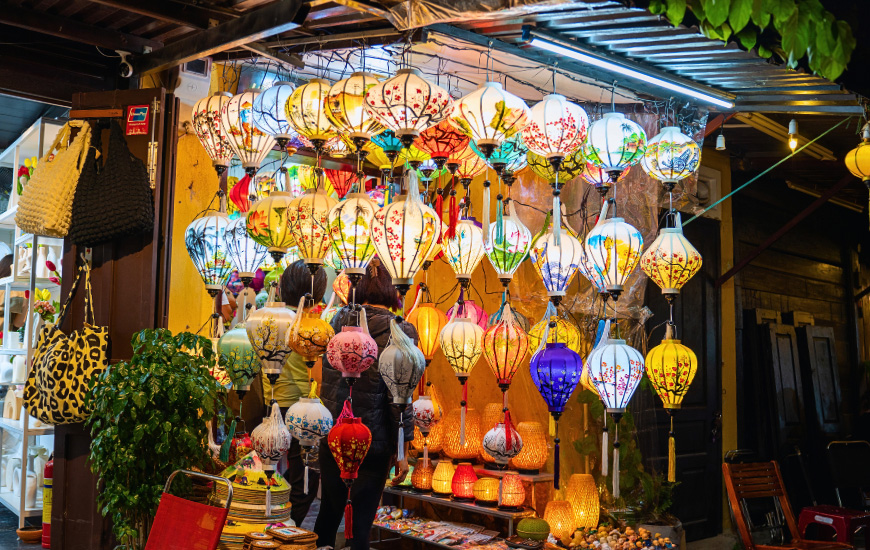 Hoi An is famous for its lanterns - Mr Linh's Adventures
Hoi An is famous for its lanterns - Mr Linh's AdventuresSavor the Flavors of Authentic Hoi An
For the discerning palate, Hoi An presents a culinary haven. Indulge in the city's signature dishes, such as the distinctive cao lau noodle dish, the delectable banh mi sandwich, or the fragrant com ga chicken rice, each a testament to the region's gastronomic excellence.
 See & Do
See & Do
Hoi An offers a multitude of activities for all tastes. Nature enthusiasts can explore the surroundings by bike or scooter, crossing through rice fields and picturesque villages. The routes are varied, but one of the most popular will take you to the village of Tra Que, a peaceful haven known for its fresh and organic products.
Imagine cycling through lush green rice fields, encountering leisurely water buffaloes, and following peaceful waterways. The village of Tra Que, with its traditional houses and lush gardens, offers a welcome break from the city's hustle and bustle. You can relax in this idyllic setting, interact with locals, and discover ancient agricultural techniques. An authentic and enriching experience that will delight your senses and nourish your spirit.
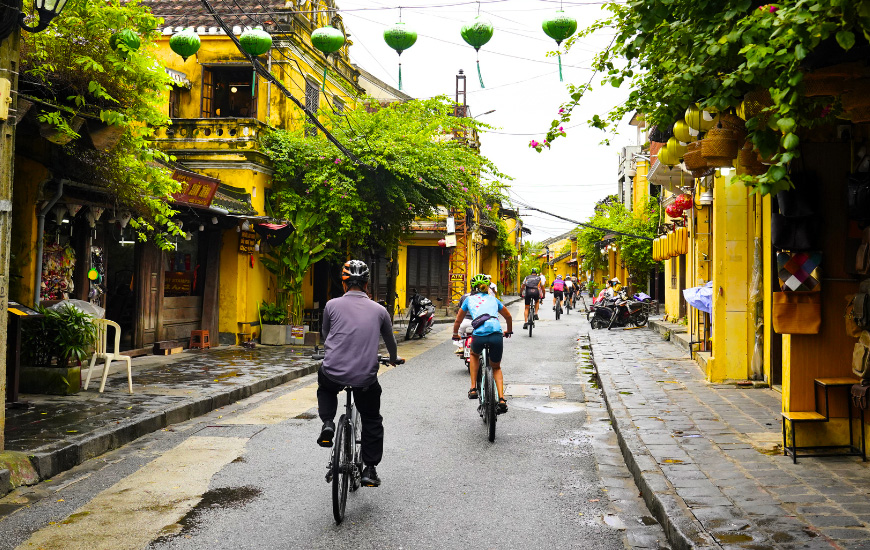 Cycling in Hoi An Region - Mr Linh's Adventures
Cycling in Hoi An Region - Mr Linh's Adventures
But the adventure doesn't stop there. Hoi An is surrounded by mountains, forests, and stunning beaches, offering countless exploration opportunities. Hoi An, beyond its historical and cultural treasures, also boasts a beautiful coastline, inviting relaxation and discovery.
An Bang Beach, with its soft white sand, turquoise waters, and tall palm trees providing welcome shade, is a true haven of peace. You can lounge under a parasol, sip a cool drink, refresh yourself by swimming, or explore the underwater world with a mask and snorkel.
The Cham Islands archipelago, located a short distance from Hoi An, is another wonder not to be missed. These paradisiacal islands, with only one inhabited (Hon Lao), host an exceptional coral ecosystem, making it an ideal spot for snorkeling. You can observe a multitude of marine species in a pristine natural setting.
Please note that access to the Cham Islands is limited from March to September due to weather conditions.
Whether you prefer beach relaxation or underwater exploration, Hoi An and its surroundings will surely delight you.
Immersion in local culture
Cam Kim Island, located in the heart of the Thu Bon River, offers an authentic immersion into the local culture of Hoi An. Recently connected to the mainland by a bridge, it has become even more accessible and invites exploration.
Cycling through this serene island is a unique experience. You can soak in the peaceful atmosphere, away from the city's hustle and bustle, and admire the beauty of the surrounding nature, between lush green rice fields and peaceful waterways.
Cam Kim Island is also a hotspot for local craftsmanship. You will encounter families passing down unique skills through generations. You can observe the artisanal weaving of colorful mats or the making of rice crackers, an essential ingredient in many Vietnamese dishes.
But Cam Kim Island is above all a place for encounters and exchanges. You can converse with locals, discover their traditions and way of life, and share a moment of conviviality over tea or a meal.
Kim Bong Village, located on the island, is renowned for its woodwork. You will be impressed by the talent and precision of the artisans, who carve unique pieces, true works of art.
 Hoi An, a paradise for shopping-addicts - Mr Linh's Adventures
Hoi An, a paradise for shopping-addicts - Mr Linh's AdventuresShopping
Hoi An, a city of history and culture, is also a paradise for shopping enthusiasts. Its pedestrian streets, lined with colorful lanterns, invite leisurely strolls and discoveries. Hoi An is renowned for its numerous tailors, offering quality garments at very competitive prices. Whether you're looking for a tailored suit, an evening gown, or a simple alteration, you'll find the expertise and the perfect fabric in Hoi An. The fabric market is a must-visit place to choose your fabric from a wide variety of colors and patterns.
But Hoi An is not just about clothing. The city is full of craft shops where you can find traditional decorative items, typical clothing, artworks, and ceramics. Whether you're looking for a unique souvenir or an original gift, you'll find the perfect item in Hoi An that will bring you joy.
 Heritage
Heritage
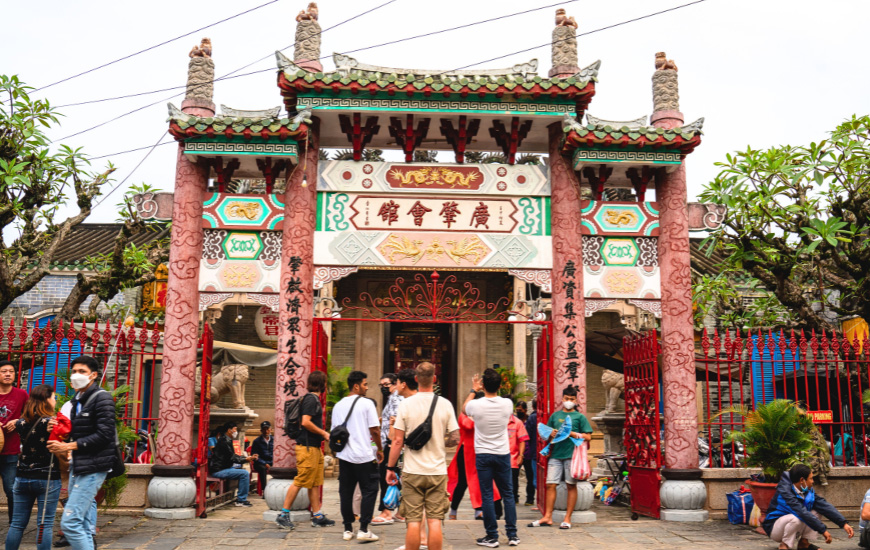 Cantonese Assembly Hall, a timeless gem of Hoi An - Mr Linh's Adventures
Cantonese Assembly Hall, a timeless gem of Hoi An - Mr Linh's Adventures
Hoi An, a gem of history and culture in Vietnam, was more than just a commercial port in the 15th century. Its origins date back to ancient times, with the presence of the Sa Huynh, a seafaring and fishing people, whose remnants date back 2,000 to 3,000 years.
In the early era, the Cham people from India established their kingdom in central Vietnam, making Hoi An an important maritime trading center. The thriving city, where silk and spices were traded, reflects the ingenuity of this people.
Over the centuries, Hoi An witnessed conflicts between the Cham kingdom, the Vietnamese people, and the Khmer people. Eventually, the Vietnamese people took control of the city, marking a turning point in its history.
Today, Hoi An is a valuable testament to its past. Its colorful streets, ancient houses, and temples bear witness to its rich cultural heritage. The city, listed as a UNESCO World Heritage Site, attracts travelers from around the world, eager to discover its fascinating history and authentic charm.
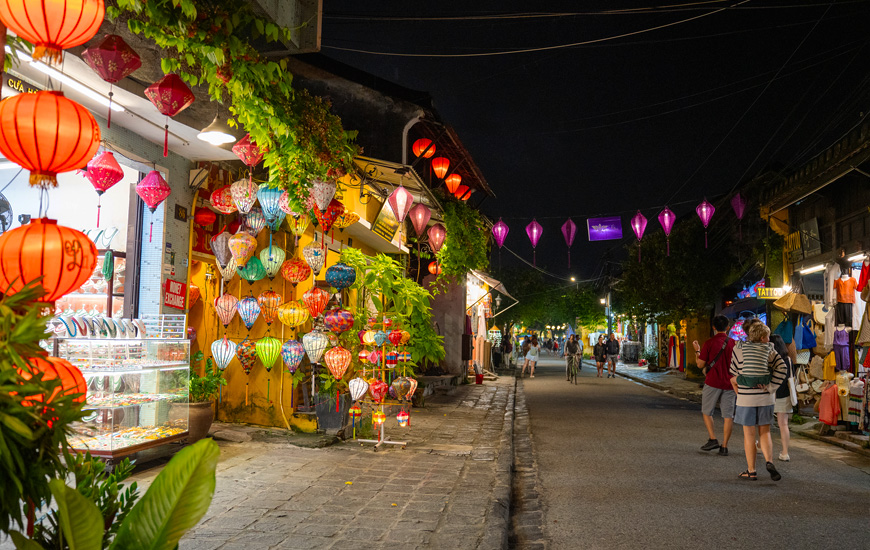 The romantic charm of Hoi An street - Mr Linh's Adventures
The romantic charm of Hoi An street - Mr Linh's Adventures
Hoi An's Old Town
home to over 1,000 traditional structures, the ancient town is an exceptional testament to its past as an international trading port. Imagine strolling through its streets, lined with wooden-framed houses, beautifully preserved temples, and pagodas. These buildings, dating back to the time when Hoi An was a hub of trade, tell the stories of Japanese, Chinese, and European merchants who lived and thrived there.
Phung Hung House
Phung Hung House, one of the most beautiful residences in the Old Town, showcases the history and refinement of Hoi An. Built in 1780, this wooden structure is a true architectural masterpiece, harmoniously blending Vietnamese, Japanese, and Chinese styles.
Upon entering Phung Hung House, you will be immediately struck by the richness of its decor. Ornamental embroideries, wall hangings, and traditional silk lanterns hanging from the rafters create a warm and authentic atmosphere. Every detail speaks to the craftsmanship of artisans of the time and the importance placed on aesthetics.
As you wander through the different rooms of the house, you will discover the history of the Phung Hung family, a family of prosperous merchants who lived there for generations. You can admire period furniture, art objects, and family mementos, all testifying to Hoi An's glorious past.
Tan Ky House
This jewel of architecture and history, is one of the best-preserved residences in Hoi An. Behind its modest facade lies a grand interior, meticulously maintained for seven generations.
Upon entering Tan Ky House, you will be immediately struck by the richness of its decor. Dark wood furniture, accented with red and gold, speaks to the luxury and prosperity of the family who lived there. Antiques and intricately carved wooden sculptures, collected over the years, bear witness to Hoi An's glorious past.
The architecture of Tan Ky House is a perfect example of the influence of the various cultures that have shaped Hoi An's history. Vietnamese, Chinese, and Japanese elements merge harmoniously. Particularly remarkable are the Chinese calligraphic poems on mother-of-pearl panels, suspended from supporting columns.
Japanese Covered Bridge
Not far from Tan Ky House stands the iconic Japanese Covered Bridge, a symbol of Hoi An. This bridge, both functional and ornamental, once connected the Japanese and Chinese quarters on either side of a tranquil tributary of the Thu Bon River.
At the bridge's entrance, two statues, one depicting a monkey and the other a dog, watch over passersby. These guardians, faithful to their role, are linked to the Japanese zodiac system.
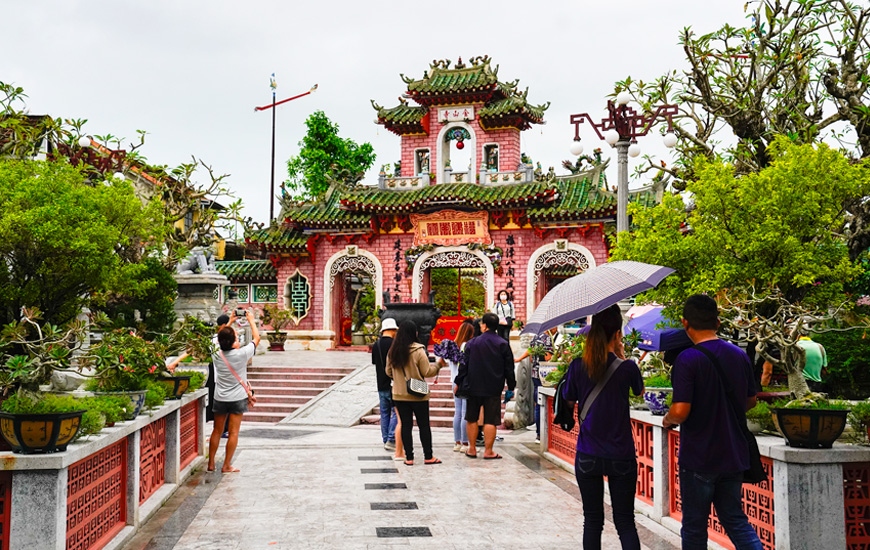 Quan Cong Temple, the most sacred temple in Hoi An - Mr Linh's Adventures
Quan Cong Temple, the most sacred temple in Hoi An - Mr Linh's AdventuresThe Chinese congregations
The Chinese congregations established in Hoi An built magnificent assembly halls to cultivate their identity and perpetuate their traditions. Five of these halls still exist today, true gems of architecture and history that reflect the city's rich cultural heritage.
Entering these halls is like stepping back in time and discovering sumptuous gardens, peaceful courtyards, and ornate temples. Each architectural detail, sculpture, and color tells the story of these communities from afar. These places of worship and conviviality have become major tourist attractions, attracting visitors from around the world, fascinated by their beauty and authenticity.
The Phuc Kien Temple
Among the most remarkable, we can mention the Phuc Kien (Fujian) Assembly Hall, dedicated to the protective goddess of sailors, or the Cantonese Assembly Hall, renowned for its sculptures and refined decorations. These buildings showcase the cultural diversity of Hoi An and the importance of commercial and human exchanges in its development.
The Fujian Assembly Hall
Built in the 17th century, this place of worship and conviviality reflects the importance of the Fujian Chinese community in the city's history. Originally a simple pagoda, the Phuc Kien Assembly Hall was transformed over time into a sumptuous place of worship and gathering. Its intricate sculptures and refined decorations depict scenes from Chinese mythology and pay homage to Thien Hau, the goddess of the sea and protector of sailors
The Cantonese Assembly Hall
Established in 1786, this is another architectural gem of Hoi An. This place of worship and conviviality showcases the importance of the Cantonese community in the city's history. As you enter, you will be impressed by the richness of the decorations and the intricacy of the sculptures. The centerpiece of the complex is a spectacular mosaic statue of a dragon emerging from a pond, symbolizing power and prosperity. Inside, the Chinese iconography, detailed gold and red sculptures, and formidable-looking dragons showcase the refinement of Cantonese craftsmanship. A section is dedicated to the memory of Chinese heroes who died during World War II, recalling the history and values of this community.
Hoi An, a melting pot of cultures, houses a fascinating collection of temples and pagodas, each dedicated to different deities. The Quan Cong Temple, built in 1653, is an important place of worship in the city. It is dedicated to the Chinese general Quan Cong, revered for his loyalty, sincerity, and bravery. Inside the temple, you can admire the imposing statue of Quan Cong, surrounded by his guardians. The architectural details, sculptures, and artworks attest to the artisans' craftsmanship and the significance of this place of worship for the local community.
My Son Sanctuary
A few kilometers from Hoi An, the My Son Sanctuary -
a UNESCO World Heritage Site - offers a fascinating glimpse into the
Champa kingdom, which ruled the region from the 2nd to the 15th century. This complex of Hindu temples, built between the 4th and 13th centuries, showcases the cultural and religious richness of this people. Although partially destroyed by American bombings during the Vietnam War, the remnants of My Son remain impressive. The red brick temples, dedicated to Shiva and other Hindu deities, demonstrate the architectural and artistic skills of the Chams. The surrounding nature, with its lush mountains and lush vegetation, adds to the site's mystical atmosphere. Walking through the ruins of My Son is delving into the history and culture of an ancient civilization while enjoying an exceptional natural setting.
Museums in Hoi An
Hoi An, a city of art and history, houses a collection of fascinating museums that allow visitors to better understand its rich past. Three of them are located in the Old Town, offering valuable insights into Hoi An's history and culture.
The Museum of History and Culture of Hoi An, located in the enchanting setting of the Quan Am Pagoda, traces the city's development from the Cham period to its peak as a trading port. The exhibited objects reflect the cultural diversity and economic importance of Hoi An over the centuries.
The Sa Huynh Culture Museum is dedicated to the region's oldest civilization. It houses a collection of artifacts dating back over 3,000 years, such as pottery, tools, and weapons, providing valuable insights into the daily life and traditions of this people.
The Museum of Commercial Ceramics, housed in a restored traditional wooden house, traces the history of ceramic trade in Hoi An. The displayed pieces, from Vietnam and neighboring countries, showcase the artisans' skills and the importance of Hoi An as a center of trade.
Festivals and Events
 Hoi An Night Market, a lantern-lit wonderland - Mr Linh's Adventures
Hoi An Night Market, a lantern-lit wonderland - Mr Linh's Adventures
Every month, during the full moon, Hoi An transforms into a magical spectacle. Electric lights go out, making way for a myriad of colorful lanterns that illuminate the city. This celebration, which takes place on the 14th day of each lunar month, is an opportunity for residents to gather, honor their ancestors, and participate in traditional games. The soft light of the lanterns creates a fairy-tale atmosphere, while ritual offerings and traditional activities animate the streets. The spectacle is particularly striking from the water, where floating lanterns illuminate the Thu Bon River. A boat ride in a sampan is the best way to enjoy this unique ambiance and be captivated by the magic of Hoi An.
Additionally, Hoi An hosts two major festivals:
The annual Chinese festival, celebrated by Chinese residents in the Guangdong and Chaozhou assembly halls. The Nguyen Tieu festival takes place on the 15th day of the lunar new year in honor of Emperor Shen Nong. People gather in temples and pagodas to make offerings to their gods and pray for health and prosperity.
The Long Chu festival is celebrated on the 15th day of the seventh and eighth lunar months to ward off diseases and health issues. A royal dragon-shaped barge descends the river to rid the city of evil. The procession includes ceremonies and rituals. Once the ceremonies are over, people join in the celebration with songs, dances, and traditional games.
 Foods & Drinks
Foods & Drinks
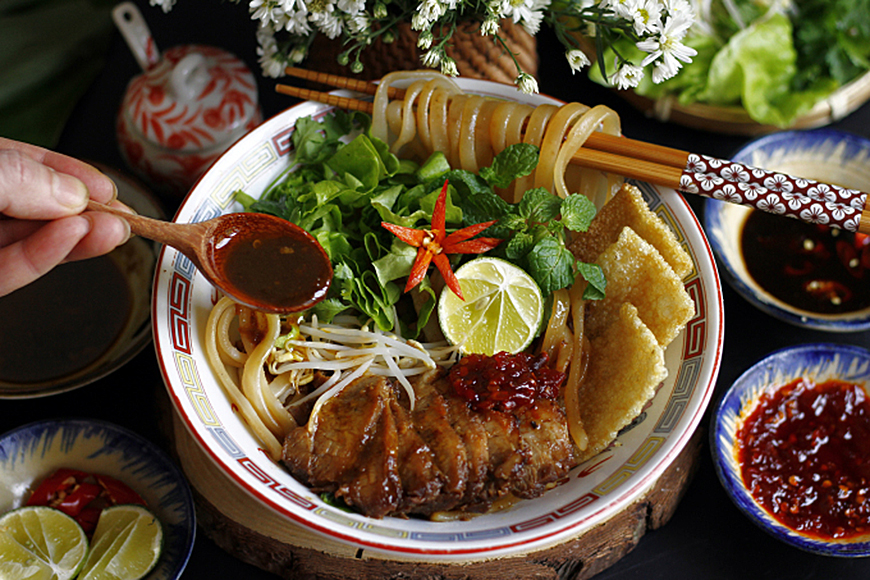 Cao Lau, the must-eat in Hoi An
Cao Lau, the must-eat in Hoi An
Hoi An's cuisine is a delight for the taste buds. Influenced by Vietnamese, Chinese, and Japanese culinary traditions, it offers a wide variety of delicious and refined dishes. Whether you're looking for authentic local cuisine, international specialties, or a simple coffee, you'll find your happiness in Hoi An.
Among the city's iconic dishes, Cao Lau and White Rose hold a special place.
Cao Lau
Cao Lau, a typical noodle dish from Hoi An, is a true delight for the taste buds. Its thick and tender noodles, served with thinly sliced pork, aromatic herbs, and a sweet and sour sauce, offer an explosion of flavors. The secret to this dish lies in its preparation, especially in the use of water from an ancient Cham well and specific Cham island ashes.
White Rose Dumplings
White Rose, or "white rose dumplings," is another local specialty. These delicate rice paper dumplings, filled with shrimp or pork and mushrooms, are steamed and served with a light, fragrant sauce. Their shape, resembling white roses, has earned them this poetic name. The recipe for this dish is a well-guarded secret, passed down from generation to generation by a family in Hoi An.
Hoanh Thanh wontons, of Chinese origin but reimagined with a Vietnamese twist, are a real explosion of flavors. These fried and crispy dumplings, filled with seasoned pork, are served with a fresh and tangy salsa made of coriander, pineapple, and cucumber. A bold marriage of textures and flavors that will delight your taste buds.
For a sweet note at the end of your meal, indulge in Xi Ma, a typical dessert from Hoi An. This black sesame pudding offers a rich and intense flavor, with notes of hazelnut. Prepared with water from local wells, it is served hot in small terracotta pots, a true delight for enthusiasts of authentic flavors.